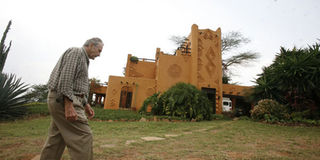A day of contrasts at the African Heritage House

Alan Donovan walks towards his African Heritage House in Mlolongo on February 13, 2014 after an interview. PHOTO | EVANS HABIL
What you need to know:
The train slowly moved us from the cramped tin shacks of Kibera, through the Industrial Area, across the Athi Plains, with sightings of the impressive Chinese-built railway, and to Alan’s mansion in the style of Africa’s ancient mud palaces.
They called it the gala night of the century. It was the African Twilight event at Alan Donovan’s place — the amazing African Heritage House on the edge of the Nairobi National Park.
A lot of effort and emotion had gone into staging what Alan has said would be his last African Heritage Festival. I have tremendous respect for what Alan has done in celebrating and supporting African art in Kenya. But this event left me in two minds.
There were contrasts — disturbing ones. And the contrasts started with the special train journey put on for the guests: from the old Nairobi Railway Station to the bottom of Alan’s garden with its view across the park. The train slowly moved us from the cramped tin shacks of Kibera, through the Industrial Area, across the Athi Plains, with sightings of the impressive Chinese-built railway, and to Alan’s mansion in the style of Africa’s ancient mud palaces.
WITHIN JUST AN HOUR
Within just an hour, if we put aside our mobile phones, we could look out of the train windows and witness the pains and the pleasures of a city like Nairobi — its poverty and its affluence, its ugliness and its beauty. It was not a comfortable journey.
There was comfort, though, in the welcome at the grounds of the African Heritage House — the chilled wines on offer, the roast meats from Carnivore and the delicious desserts from the Nairobi Serena.
The event itself started with a very moving tribute to Ayub Ogada, the musician who passed away just a few weeks ago. He was the co-founder of the African Heritage Band, back in 1979. His playing of the Nyatiti, his Luo guitar, was quite magical. He would have opened the show last Sunday.
The event that followed was in two parts, and I have different feelings about them. One was given over to a presentation by the photographers, Carol Beckworth and Angela Fisher, who were promoting their lavish two-volume book, ‘African Twilight: the Vanishing Cultures and Ceremonies of the African Continent’.
40 YEARS
For 40 years they have journeyed around Africa, visiting traditional communities and recording their ceremonies, customs and costumes.
Their books are beautifully photographed and, yes, they make a record of cultures that will evolve if not disappear. But there was something about the manner of their presentation that made me wonder what would happen if three guys dressed in full Maasai regalia and carrying cameras and notebooks visited Carol’s and Angela’s communities in the States or Australia and asked if they could visit homes and record behaviours. I wonder what reception they would get.
The second half of the show was a recreation of the African Heritage Festivals that Alan Donovan has travelled around the world over the years, promoting African arts, fabrics, fashions — and Kenyan tourism. It was a catwalk display of clothes derived from traditional African dress: all colourful and imaginative — sometimes stunning. It also involved bendiflex acrobats and some quite erotic dances.
However, the photograph I have chosen is of the venue, African Heritage House. It is because, though the event is over — and, sadly, it might be the last festival of its kind — you can still see a superb collection of African art and fabrics in either the African Heritage House or the Nairobi Galley, which is at the corner of Kenyatta Avenue and Uhuru Highway.
It has been said African Heritage House is the most photographed house in Africa. That could well be true. And inside is a treasure trove of art and design. Day visits can be arranged — even overnight stays.
You can get more information at africanheritagehouse.info. Also, you can see the superb Joseph Murumbi collection of African art at the old PC’s office next to Nyayo House — and get an excellent coffee at its Pointzero Café.
John Fox is Managing Director of iDC Email: [email protected]





